When John Murdy was an elementary school kid, his grandma would often don a monster mask, hide in the closet and scare the crap out of him when he got home, taking delight in his surprised reaction and startled screams — and showing dedication to the scare too, chasing him outside and sometimes even around the neighborhood. One night when his parents went out to dinner, granny had an idea. “Why don’t we all pretend like we were murdered?” she asked Murdy and his young sister. The children proceeded to lie down on the floor, splattered with ketchup while knives were placed around them. It made for quite a sight when mom and dad got home.
These experiences might’ve been traumatic for some kids, but for L.A. native Murdy — who shares his story in the documentary Haunters: The Art of the Scare (currently on Netflix) — they were formative. He would go on to create spooky environments for his family and friends for years to come, eventually turning his talent for terror into a career as creative director of Horror Nights, the highly successful haunt at Universal Studios Hollywood.
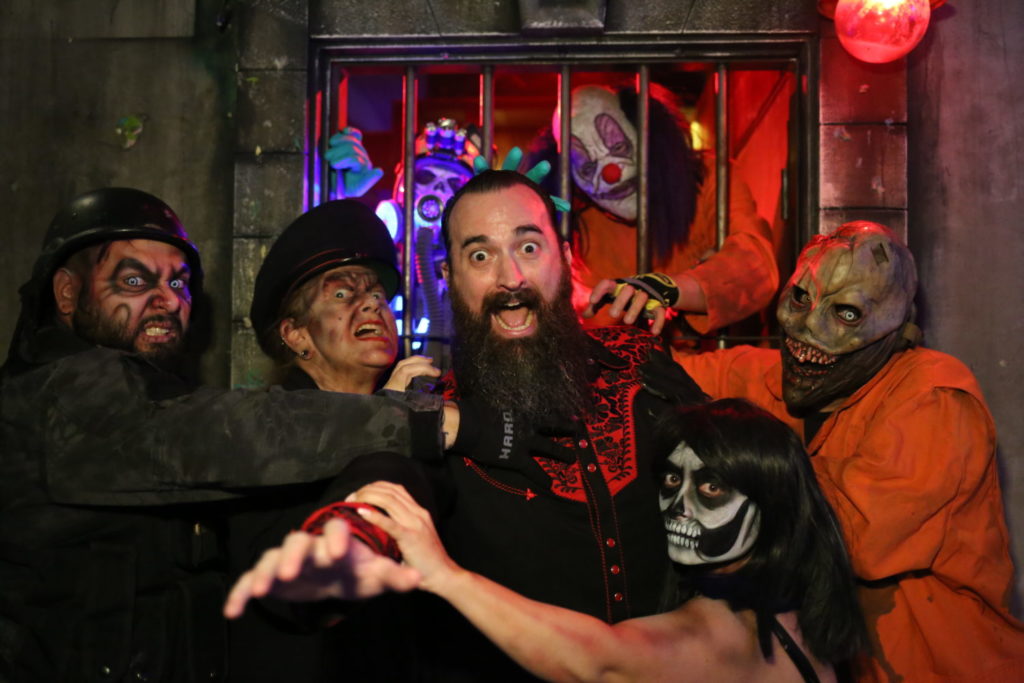
Jon Schnitzer and fiendish friends inside extreme haunt The 17th Door (Kevin Tolby)
Murdy recounts his ghoulish grandma in the bonus footage on the DVD for Haunters, and the doc proves he is by no means alone when it comes to an enduring nostalgia-fueled passion for horror, haunts and the Halloween season that brings it all to the masses every year. Halloween in Southern California is particularly huge, with more things to do than maybe anywhere else. From home haunts to major theme park attractions to pop-ups to pumpkin patches to immersive theater experiences to horror screenings to art shows to VR to costume parties to family events, there is so much to do this time of year, it really is scary.
So why are so many of us fascinated with spooky stuff? “That’s the big question. My life has now been consumed with Halloween and designing fearful amusements, but I can’t tell you the reason exactly why I’m so drawn to this particular genre of macabre entertainment,” shares Jon Cooke of Plague Productions, the creative director of this year’s Los Angeles Haunted Hayride in Griffith Park. “My best guess is life can be tough [and] there is a lot of pressure with social expectations, but with horror all that goes out the window. It’s a raw, uncensored art form where we as people on both sides of the scare get to let loose, laugh, scream and have a good time, because at the end of the day that’s what this is all about — having fun.”
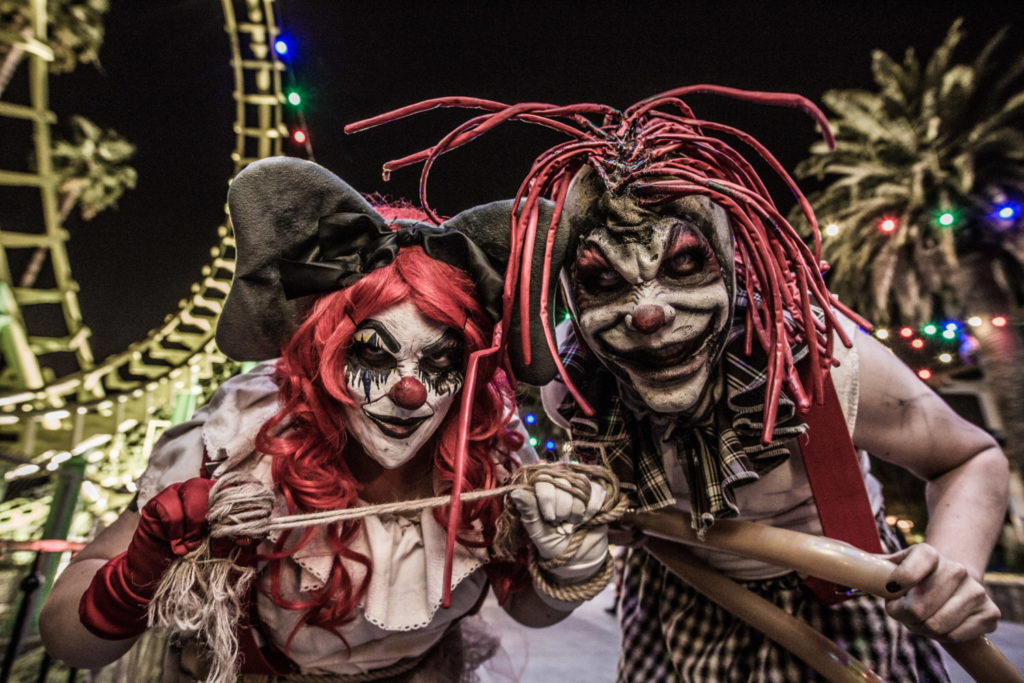
A carnival of creeps has come to town. (Courtesy Knott’s Scary Farm)
Haunters filmmaker Jon Schnitzer was obsessed with creepdom since he was a kid growing up Huntington Beach, making his own neighborhood haunted houses and eventually creating a production company called The Brain Factory — so he could do them bigger and better for corporate clients. Four years of filming and interviews led to the documentary, which provides an in-depth look at the people behind these frightful destinations and a history lesson about where they came from. He says home haunts began, ironically, via church groups — Campus Life Youth for Christ — who created them to raise money for charities and the church as early as the 1920s, while the amusement park world of wicked environments (“scare zones”), mazes and jump scares was first created by Knott’s Berry Farm in Buena Park in the early 1970s. Decades later, Knott’s continues to provide ground-breaking experiences in terms of themes, animatronics and scare actors. (Schitzner says they were the first to use clickers and sliders to surprise and spook guests throughout the park.)
Universal Studios soon followed with its cinematically-driven, high-production offerings, and the rest is haunted history. Queen Mary’s Dark Harbor, Six Flags’ Fright Fest and several others have thrown their witchy hands into the Halloween cauldron of events, which keeps everyone in the biz on their terror-ific toes. Universal, by the way, is consistently tops thanks its ability to get the actual effects people from its films involved in its thematic mazes, makeup and set-up. After seeing their scary slate this year with Stranger Things, Killer Clowns From Outer Space and Jordan Peele’s Us (our favorite filmic recreation) we bestow them with the killer creepster crown his year.
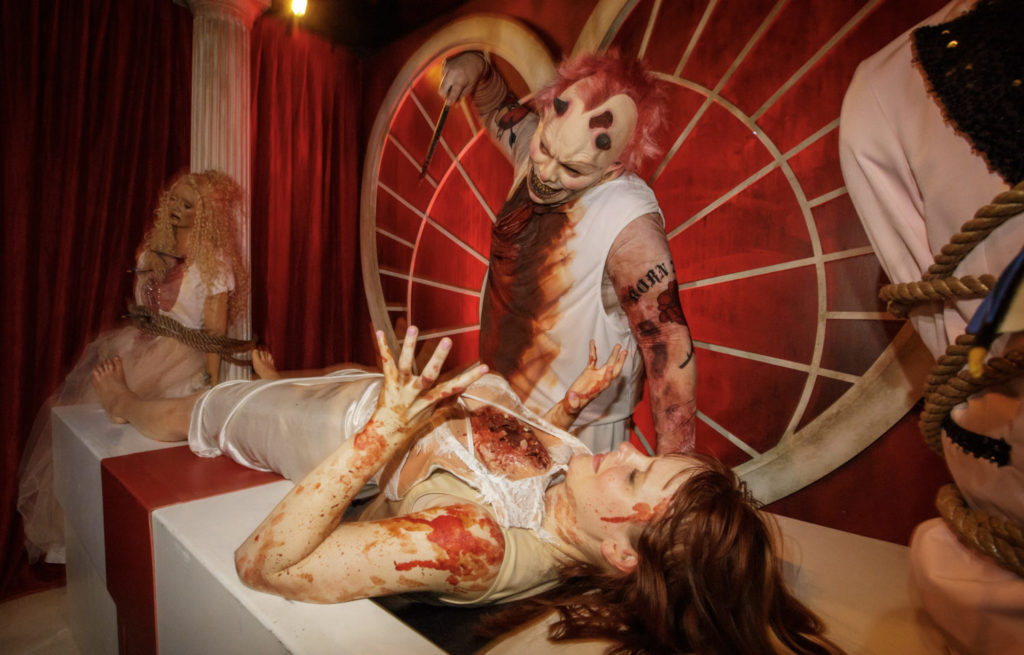
Heartfelt scares at Halloween Horror Nights at Universal Studios (David Sprague).
Though Disneyland never got into the biz of scaring people, the success of its legendary Haunted Mansion — currently celebrating its 50th anniversary — was surely a precursor that proved ghosts and ghouls had theme park appeal. In addition to the Mansion’s Nightmare Before Christmas makeover every year, Disneyland’s California Adventure has gotten into the season bigtime for 2019, with Halloween decor throughout and an “Oogie Boogie Bash” offering trick or treating with Disney villains and much more.
On the other end of the spectrum, Schitzner says the L.A. area has some of the best spine-chilling encounters in the country, some of which push the fear factor boundaries such as the 17th Door in Orange County (“an incredible full contact haunt”), Rotten Apple in the Valley and Reign of Terror in Thousand Oaks. These are seen briefly in his film, but more time is given to the most extreme haunts of all, such as New York’s brutal walk-thru known as Blackout (started in 2009) and the infamous McKamey Manor, a hellish house of horrors that seems more like an exercise in torture and humiliation than a traditional jump scare escapade. The latter is so controversial it was forced to leave its homebase in San Diego and now has two locations — one in Nashville, Tennessee and one in Huntsville, Alabama. It’s become world famous regardless, thanks to creator Russ McKamey’s dreadfully dramatic videos, which get major viewing numbers on YouTube.
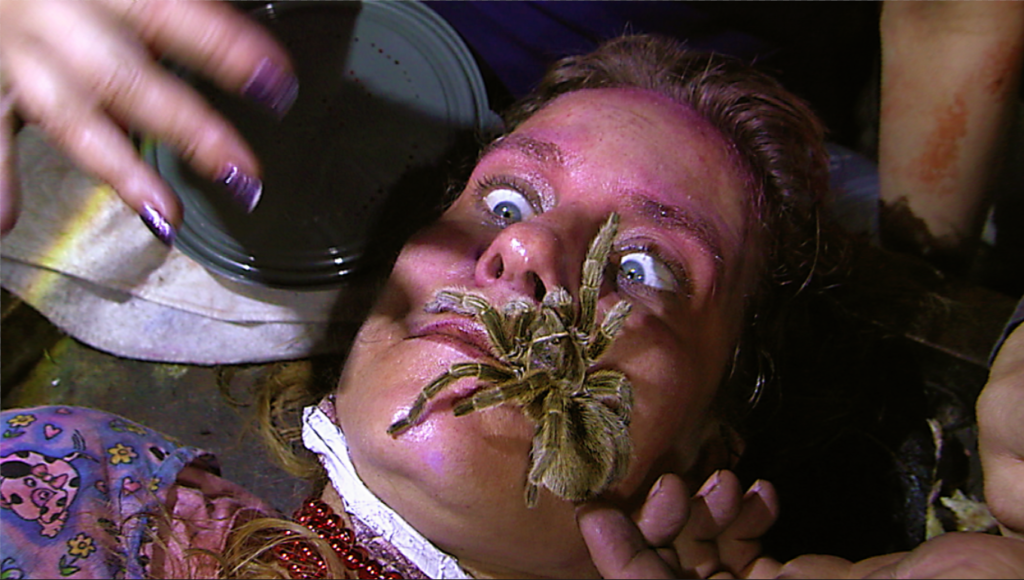
Scene inside McKamey Manor from Haunters. (Courtesy Jon Schnitzer)
Though Haunters seeks to humanize McKamey somewhat, his brand of haunt is harrowing and even gross (people have been forced to eat their own vomit, and/or be submerged in foul-smelling liquids), which makes it pretty niche. Unlike many extreme haunts they didn’t even have a safe word if people decided they had enough. According to Schitzner, they do now.
In many ways the classic haunted house was the first example of immersive entertainment. You were put into a situation and you were made to react and interact. The extreme haunts do allow touching though often it is not a two-way street; the actors may touch you, but not vice versa. This is also the case with many of L.A.’s hot new theatrical submersions such, as Haus of Creep (which takes you inside a demented — and deadly — art show), Bite (which invites you to have dinner with a family of vampires), House of Spirits (which meshes booze with “boos!” to spine-tingling effect), and Alt Delete (a time-travel themed production which evolved from the popular horror play known as Delusion).
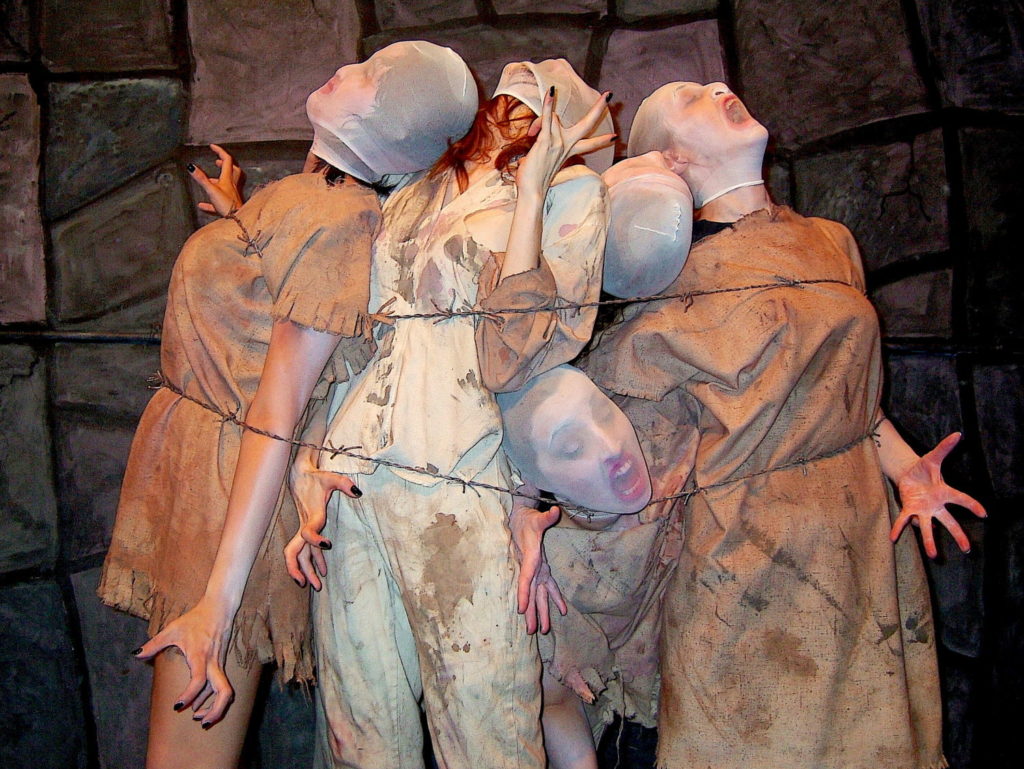
Urban Death Tour of Terror (Jana Wimer)
Many of the actors in these productions got their start at Zombie Joe’s Underground Theatre in North Hollywood, which has been putting on wonderfully bizarre episodic productions for years, but stepped up their haunt game in 2005. Zombie Joe says his “French expressionistic tableaux-style theater of cruelty and stage horror” became more streamlined when he joined forces with Jana Wimer in July 2005 to “bring a wordless, living-storied haunted-museum-coming-at-you presentation,” as he calls it, to the public.
Urban Death grew out of a “hybrid-mutt-style West Coast theatrical brand of horror covering many different genres,” says Joe. “We wanted to present a universal horror show that all nations and languages could comprehend and enjoy, the dark language of the blackened heart. And we have since taken Urban Death all over the world.”
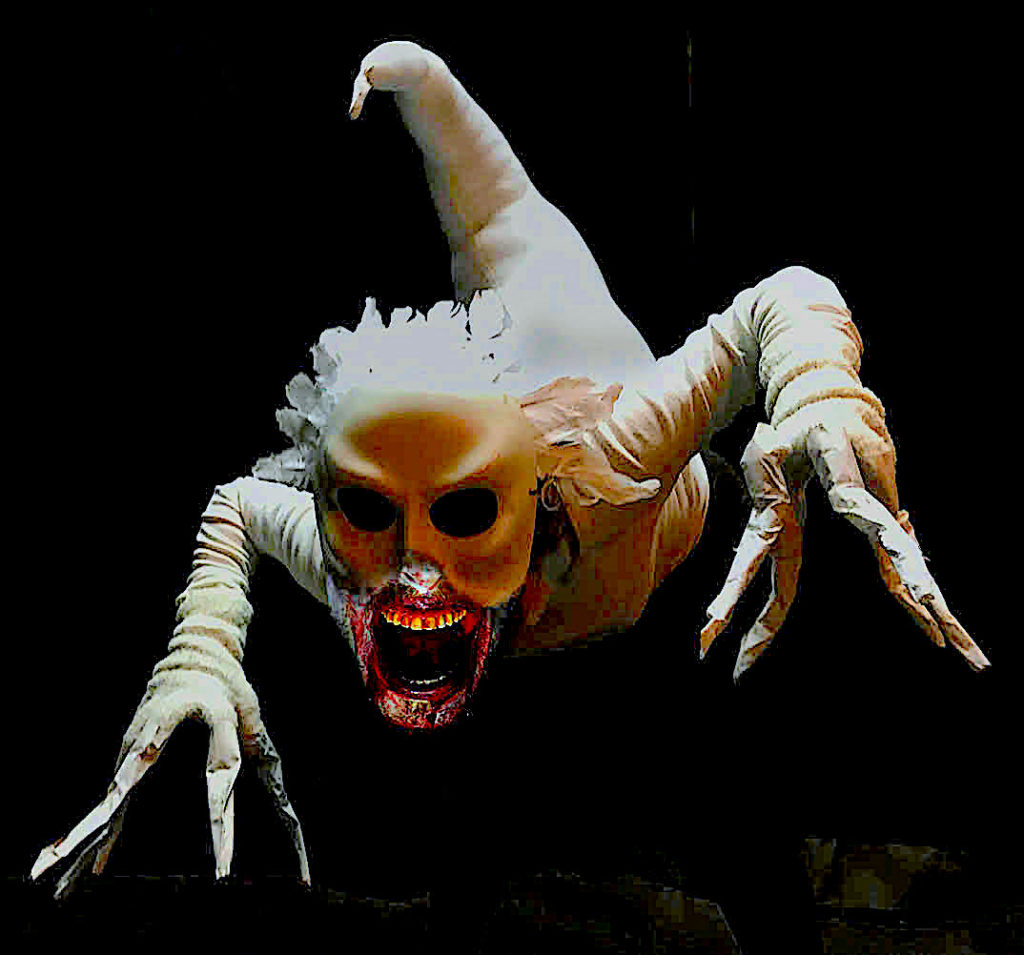
Urban Death Tour of Terror (Jana Wimer)
Though today’s haunts tout “immersive” forms of fear, Joe prefers the word “experiential” for what he does. Zombie Joe’s plays with darkness, sound and disturbing imagery, even nudity, providing one of the more powerful and weird multi-sensory environments in town. His actors get up real close but (other than using their hands to gently guide people along) try not to cross the line of physically touching their audiences.
“It’s difficult for us to even define what ‘immersive’ actually encompasses these days,” Joe admits. “The term has expanded to have such a broad meaning. The most important thing is being transparent with everyone — performers and audience — as to what to expect and/or how everyone will be handled and cared for for each specific experience.”
“Immersive has been a buzz word for a long time now,” says Melissa Carbone, who created the Haunted Hayride and followed it up with a horror-themed camp out, also in Griffith Park. “[It] isn’t new, but the need for it has probably been the thing that has caused it to surge in topic. First, I think we are in a moment where we are coming full circle with technology and developing a need for visceral, unplugged moments in our lives. We want those moments to feel good and give us a break from the heaviness of politics, conflict, financial problems, tragedy. Entertainment that can achieve a suspension of disbelief that takes you out of the real world and into a fake one wins. Secondly, there is simply a chemical physical reaction to immersion into your sensors; like a physical dopamine reaction — adrenaline. That’s always been something the public seeks out and is a byproduct of being immersed.”
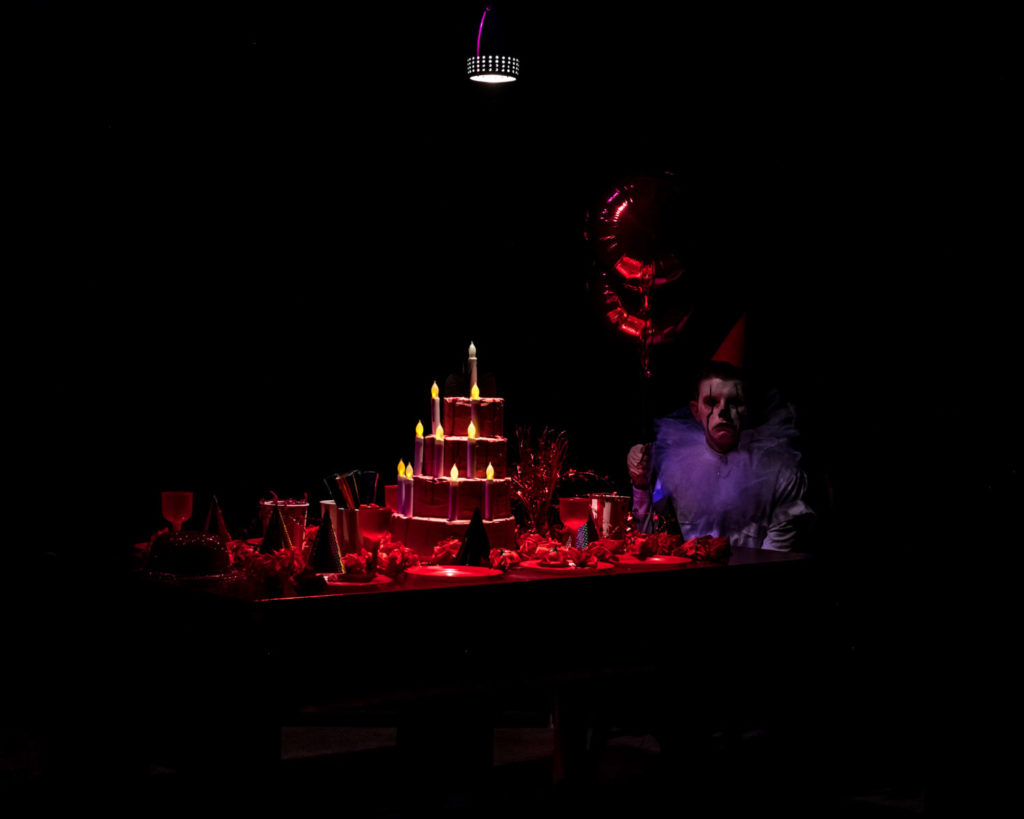
Haus of Creep (Hatbox Photography)
The popularity of dark, menacing and even violent entertainment does seem to coincide with what’s happening in the world, and as Schitzner explains, that’s because “with horror we can face our worst fears and we can escape them. That’s catharsis.”
According to WalletHub, about 50 percent of Americans will decorate their home for Halloween, 45 percent will carve a pumpkin, 32 percent will throw a party, 48 percent will dress up, and a total of 41 million kids will trick or treat. Twenty-one percent will actually visit a haunt. It all amounts to $9 billion industry that shows no sign of going away anytime soon, especially if what Schitzner says about haunted holiday revelry and horror in general thriving in times of distress and uncertainty, is true.
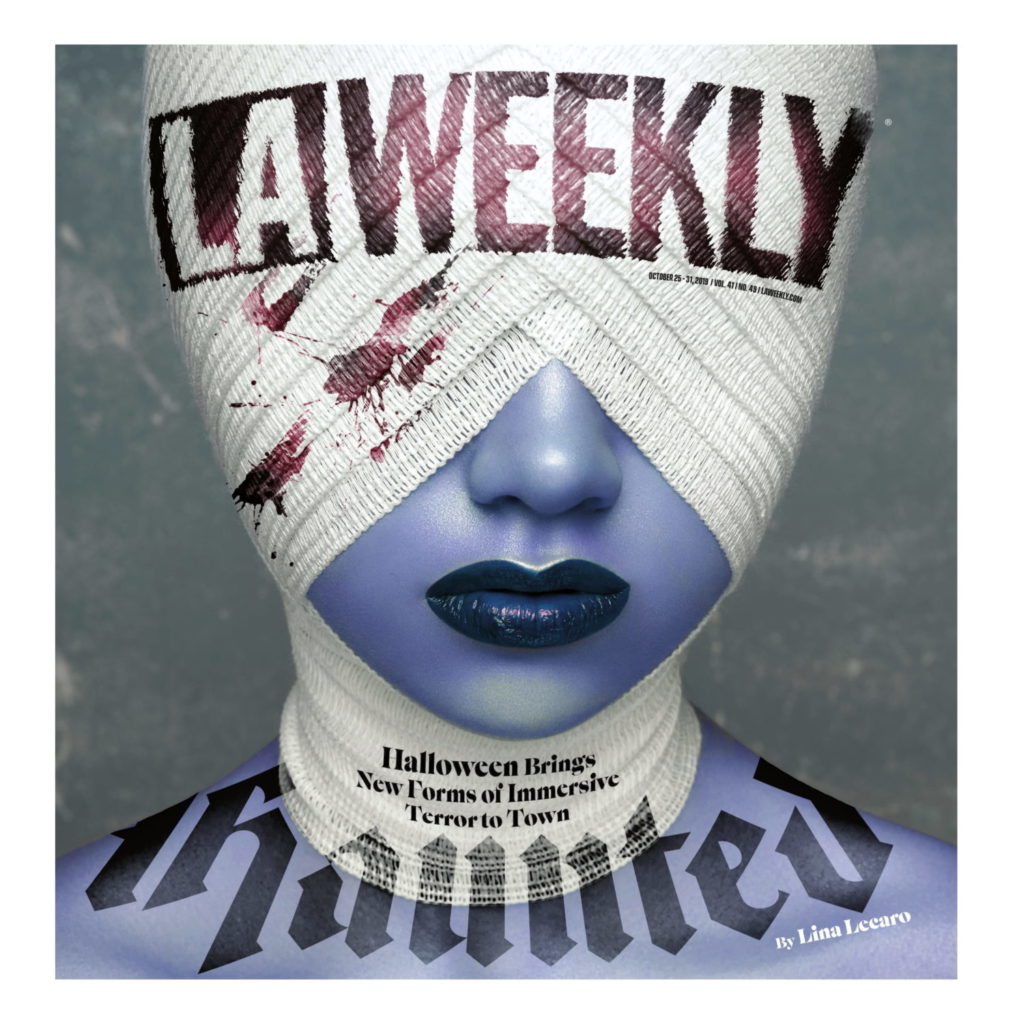
Read this cover story in L.A. Weekly’s print edition.
It would seem as though, even outside of Halloween, love of horror is at an all time high, especially in Los Angeles. The “I Like Scary Movies” Pop-Up, for example, has returned for the season, but it had a highly successful run in the summertime. Monsterpalooza is one of L.A. most highly touted and best attended conventions and it happens nowhere near Halloween time, nor does its spawn event, Son of Monsterpalooza. Monsters are in fact, so popular in Los Angeles, they’ve even made a home at the Natural History Museum. “Natural History of Horror,” a new exhibit which timed its debut to Halloween but will be on display through April 19, 2020, hopes to attract Angelenos with a “curiosity for mysterious, eerie and grotesque monsters,” according to press materials. The exhibition explores the scientific inspiration for classic monsters from Dracula, Frankenstein, The Mummy, and Creature from the Black Lagoon with rare movie props, film footage, hands-on activities, and museum specimens.
Though it’s based on the Celtic festival of Samhain, few of us ever think about the ancient tradition behind Halloween. Back when the holiday originated costumes were worn to frighten away ghosts, not to go door to door asking for candy. So in a very authentic sense, haunts and the scares they provide are the most reverent form of Halloween observance and celebration there is.
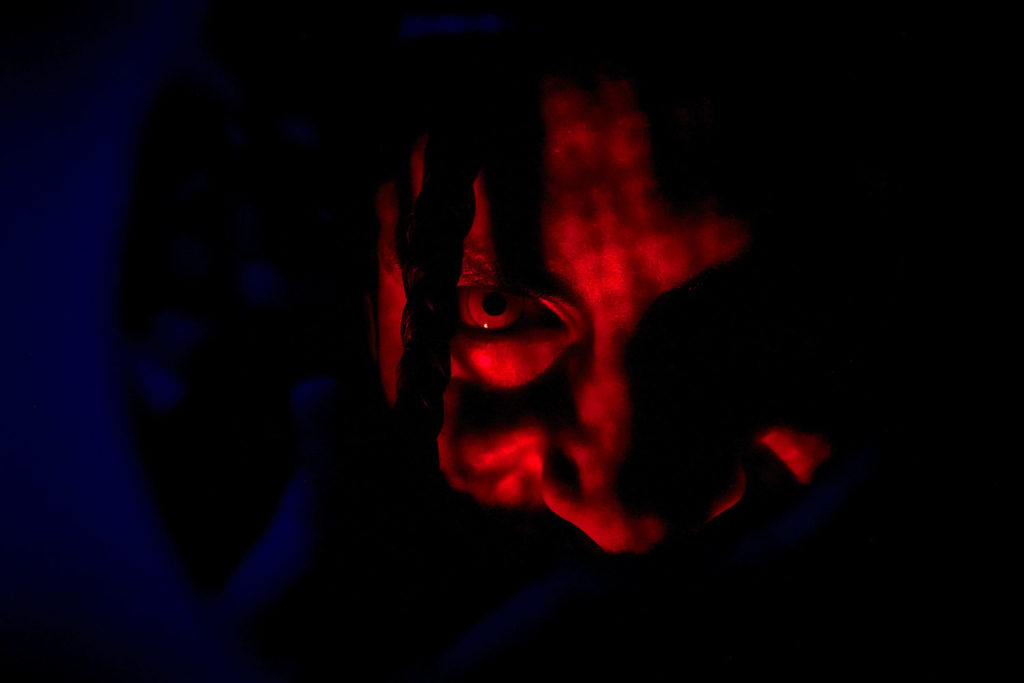
Haus of Creep (Hatbox Photography)
“Sometimes you need darkness to expose the light,” proclaims Schitzner, who plans to do just that with his next film projects, and says he’ll always be a fan of in-the-flesh haunted experiences too. “There’s so much scary, spooky fun that’s out there that we can all get lost in. I love that cosplay is such a big thing now too. And that TV shows like The Walking Dead are still popular. We even have networks devoted to horror like Shutter.”
“People who create haunts have an unbridled enthusiasm and passion to entertain, the kind many of us only had as kids,” adds Schitzner. “They’re not thinking about making money. They’re thinking about giving you the time of your life.”
If you’re afraid for your life — even for one horrifically hot second — all the better.
Check out our Monstrous Guide to Scaring Up Halloween Fun in L.A.
Haunters: The Art Of The Scare is available on DVD, Blu-ray or iTunes; hauntersmovie.com.
Venue Information
Halloween Horror Nights at Universal Studios Hollywood, 100 Universal City Plaza, Universal City. hhntickets.universalstudioshollywood.com. (Runs through Nov. 3)
Haunted Hayride, 4801 Griffith Park Drive, Griffith Park. losangeleshauntedhayride.com. (Runs through Nov. 2)
Knott’s Scary Farm, 8039 Beach Blvd, Buena Park. knotts.com/tickets-passes/scary-farm. (Runs through Nov. 2)
Six Flags’ Fright Fest, 26101 Magic Mountain Parkway, Valencia. sixflags.com/magicmountain/special-events/fright-fest#ref42949. (Runs through Nov. 2)
Disneyland Halloween & Oogie Boogie Bash, 1313 Disneyland Drive, Anaheim. disneyland.disney.go.com/events-tours/halloween-time-at-the-disneyland-resort/. (Runs through Oct. 31)
Zombie Joe’s Urban Death, 4840 Lankershim Blvd., North Hollywood. zombiejoes.com. (Runs through Nov. 2)
Haus of Creep, 777 Alameda St.,The Row DTLA,
downtown. creepla.com. (Runs through Nov. 3)
House of Spirits, secret location halfway between Culver City and downtown L.A. houseofspiritsla.com. (Runs through Nov. 2)
Bite Vampire Dinner Theater, address upon ticket purchase. horrorescapesla.com/bite-vampire-dinner. (Select dates through Nov. 31)
The Queen Mary’s Dark Harbor, 1126 Queens Highway, Long Beach. queenmary.com. (Runs until Nov. 2)
17th Door, 1851 W Orangethorpe Ave, Fullerton. the17thdoor.com. (Runs until Nov. 2)
Rotten Apple, 907 N California St, Burbank. rottenapple907.com. (Select dates through Oct. 31)
Reign of Terror, 197 N. Moorpark Road, Thousand Oaks. rothauntedhouse.com. (Runs through Nov. 2)
I like Scary Movies, 2118 East 7th Place, downtown. ilikescarymoviesexperience.com. (Runs through Nov. 17)
Natural History of Horror, Natural History Museum of Los Angeles County, 900 W. Exposition Blvd., Exposition Park. nhm.org/natural-history-horror. (Runs Through April 2020)
Advertising disclosure: We may receive compensation for some of the links in our stories. Thank you for supporting LA Weekly and our advertisers.

